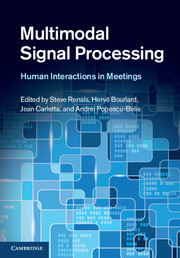Book contents
- Frontmatter
- Contents
- List of contributors
- 1 Multimodal signal processing for meetings: an introduction
- 2 Data collection
- 3 Microphone arrays and beamforming
- 4 Speaker diarization
- 5 Speech recognition
- 6 Sampling techniques for audio-visual tracking and head pose estimation
- 7 Video processing and recognition
- 8 Language structure
- 9 Multimodal analysis of small-group conversational dynamics
- 10 Summarization
- 11 User requirements for meeting support technology
- 12 Meeting browsers and meeting assistants
- 13 Evaluation of meeting support technology
- 14 Conclusion and perspectives
- References
- Index
2 - Data collection
Published online by Cambridge University Press: 05 July 2012
- Frontmatter
- Contents
- List of contributors
- 1 Multimodal signal processing for meetings: an introduction
- 2 Data collection
- 3 Microphone arrays and beamforming
- 4 Speaker diarization
- 5 Speech recognition
- 6 Sampling techniques for audio-visual tracking and head pose estimation
- 7 Video processing and recognition
- 8 Language structure
- 9 Multimodal analysis of small-group conversational dynamics
- 10 Summarization
- 11 User requirements for meeting support technology
- 12 Meeting browsers and meeting assistants
- 13 Evaluation of meeting support technology
- 14 Conclusion and perspectives
- References
- Index
Summary
One of the largest and most important parts of the original AMI project was the collection of a multimodal corpus that could be used to underpin the project research. The AMI Meeting Corpus contains 100 hours of synchronized recordings collected using special instrumented meeting rooms. As well as the base recordings, the corpus has been transcribed orthographically, and large portions of it have been annotated for everything from named entities, dialogue acts, and summaries to simple gaze and head movement behaviors. The AMIDA Corpus adds around 10 hours of recordings in which one person uses desktop videoconferencing to participate from a separate, “remote” location.
Many researchers think of these corpora simply as providing the training and test material for speech recognition or for one of the many language, video, or multimodal behaviors that they have been used to model. However, providing material for machine learning was only one of our concerns. In designing the corpus, we wished to ensure that the data was coherent, realistic, useful for some actual end applications of commercial importance, and equipped with high-quality annotations. That is, we set out to provide a data resource that might bias the research towards the basic technologies that would result in useful software components. In addition, we set out to create a resource that would be used not just by computationally oriented researchers, but by other disciplines as well. For instance, corpus linguists need naturalistic data for studying many different aspects of human communication.
- Type
- Chapter
- Information
- Multimodal Signal ProcessingHuman Interactions in Meetings, pp. 11 - 27Publisher: Cambridge University PressPrint publication year: 2012
- 1
- Cited by

